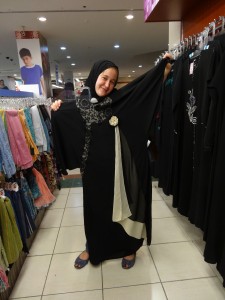
After growing up with horses, I was confused by the idea of cowboy boots and jeans as a fashion statement, since they were meant for a specific way of life. Jeans are low-maintenance and rip-resistant, perfect for getting down and dirty; cowboy boots are designed for safety on a horse’s saddle. These clothes aren’t just something to be put on, they’re a way of life. They weren’t designed to look good; they were designed to get the job done.
Even though I’m not with my horses anymore, I continue to wear jeans out of tradition. Abaya, thobe, and hijab are the Middle Eastern versions of jeans and cowboy boots. Just as some Americans wear jeans and cowboy boots to identify with a certain past – even if they’ve never ridden a horse! – these clothes are also worn out of tradition. However there are still people who wear jeans or abayas for the purposes they were intended for – and of course, there’s people somewhere in-between.
One abaya-clad classmate revealed to me that outside of the university she wears completely Western clothing with no head covering. In the UAE, wearing abaya can be both a status symbol and form of protection, and the girls who wear it for these reasons alone are usually Emiratis. In fact, women who wear abayas with black headscarves are almost always Emiratis, and they’re almost never seen without these clothes. To describe it in one phrase, there’s a culture of “pimp my abaya”. Women spend hundreds or thousands of dollars on abayas full of lace, beads, and trimmings. Other women wearing abaya for non-religious reasons wear it to protect them from gossip. Since Emiratis are only about 20% of the population, everyone knows each other somehow, and rumors can spread like wildfire. Abaya makes it less likely that people will find something to gossip about.
Of course, there is no cut and dry; some women wear abaya purely for reasons of modesty. It has the same effect as a school uniform. When everyone is wearing a black dress, people will judge otherd based on the content of their character instead of their clothes. This encourages equality and focuses attention on what’s in a person’s heart, all of which are goals of Islam.
Continuing on to hijabi girls, the decision to wear a hijab is highly celebrated – comparable to an American deciding he or she wants to go to college. Of course, some women wear hijab for non-religious reasons, but there is less societal pressure on non-Emirati girls to wear hijab. Most hijabis that I have met are extremely passionate about their hijab – just like many girls in abaya! – , and this word also refers to the concept of leading a modest lifestyle.
In general, wearing these clothes for religious purposes entails a different way of life. It marks a greater commitment to Islamic beliefs, and many girls put off wearing these clothes because they’re not yet ready for the transformation that these clothes involve. Hijab and abaya mean living a modest lifestyle, such as avoiding physical relations with guys, not going to parties with alcohol, and treating others kindly. Just as cowboy boots and jeans serve many different purposes, so do hijab and abaya.
Although I currently have no idea why some men wear thobes and others don’t, I hope to find out in the near future!